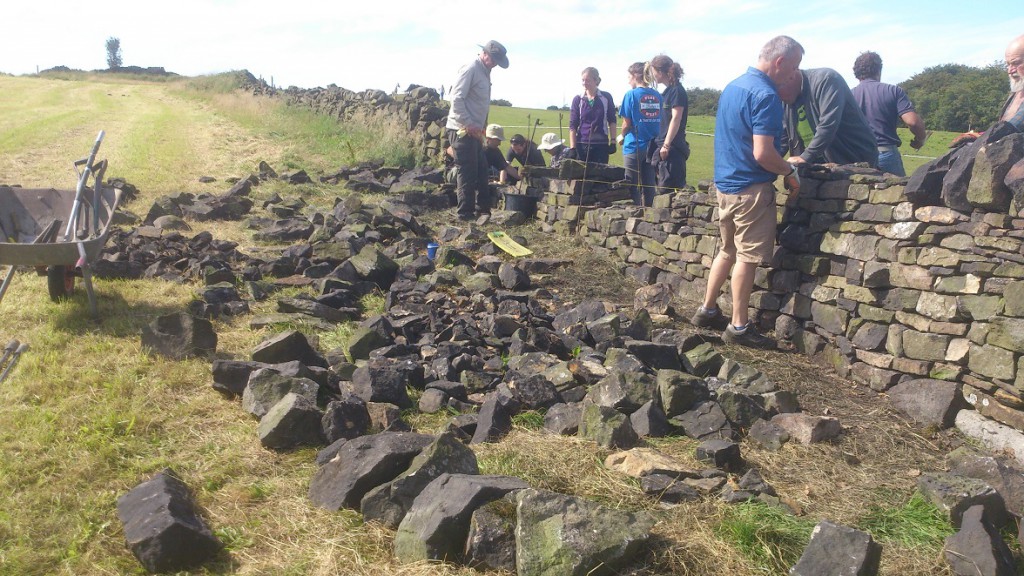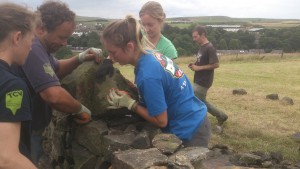
It’s a lovely sunny weekend in Baxenden (aka home of the Holland’s Pie factory) and a group of TCV volunteers are hard at work in a grazing field on the slopes of the Rossendale valley, dry stone walling.
I don’t know if you’ve ever tried dry stone walling before, but it was my first time, and flippin’ ‘eck it was tricky! We reached the site on Saturday morning and Katie gave us the low down – a bit of the how and why behind the traditional craft.
Dry stone walling dates back to the Iron Age. There are dry stone buildings still standing in the Orkneys at Skara Brae which were built 3600 years ago! The whole walling craze came about as a result of a series of Inclosure Acts in the British Isles, 1604 to 1914, which resulted in the creation of legal property rights to land that was previously considered common. Since 1947 we have lost more than 5000 miles of dry stone walls in England and Wales, mainly due to neglect, damage and the extension of fields to accommodate larger farm machinery.
Dry stone walls are a refuge for a surprisingly large array of plants and animals – in fact as we were dismantling our wall we found a load of frogs, an Emerald Ground Beetle and a Field Vole! Animals are able to hide and nest in the crevasses of the wall and plants grow on weathered areas of rock and in pockets of windblown soil. A wall may also be the only form of shelter for larger animals and livestock on open moorland.
Styles of walling vary reg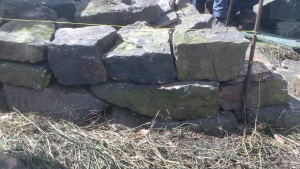 ionally, depending on the quantity and quality of the rock available.In Lancashire the underlying geology is made up of Millstone Grit and Sandstone, sedimentary rock with distinct layers. The presence of layers allows shaping into roughly block shaped pieces which you can’t do in areas of harder geology.
ionally, depending on the quantity and quality of the rock available.In Lancashire the underlying geology is made up of Millstone Grit and Sandstone, sedimentary rock with distinct layers. The presence of layers allows shaping into roughly block shaped pieces which you can’t do in areas of harder geology.
Our first task was to dismantle the collapsed wall and sort the stone by size. Generally the stones used diminish in size towards the top of the wall. As the larger stone are used first they are placed nearer to the wall. Coping stones, the stones placed along the top of the wall, and throughstones, longer stones which tie each side of the wall together, are selected and kept to one side.
W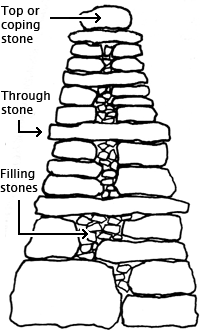 e were paired off, each person to build either side of the wall. In Lancashire the “double wall” technique is used, creating two faces and infilling with smaller stone (hearting stone) in the centre. Once the previous wall was dismantled, we got to work on setting large foundation stones to act as a firm, level base.
e were paired off, each person to build either side of the wall. In Lancashire the “double wall” technique is used, creating two faces and infilling with smaller stone (hearting stone) in the centre. Once the previous wall was dismantled, we got to work on setting large foundation stones to act as a firm, level base.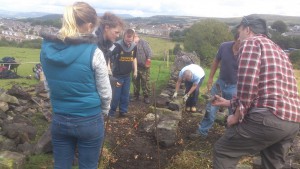
The wall i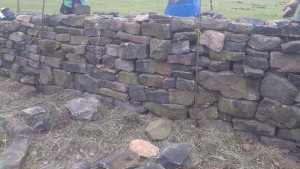 s built up of horizontal lines of stones, or courses. Each subsequent layer’s stone rests on the top of a joint to increase the wall’s stability (like when you’re building with lego!)
s built up of horizontal lines of stones, or courses. Each subsequent layer’s stone rests on the top of a joint to increase the wall’s stability (like when you’re building with lego!)
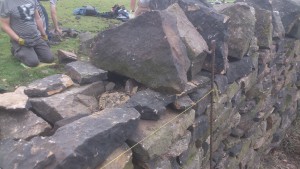
The wall narrows towards the top and follows a specific batter – a fixed template which dictates the dimensions of the wall (i.e. ours was 23cm at the base and 13 at the top). Once built to the right height, coping stones are added on top which span the width of the wall.
The whole experience was a bit of a whirlwind of emotions from exaltation when finding the perfect stone, to extreme frustration when nothing would fit (heightened by my exhaustion after camping the previous night)! It took us less experienced wallers two full days to complete only 1 metre of wall, whereas an experienced dry stone waller can build around 10 metres in a day!
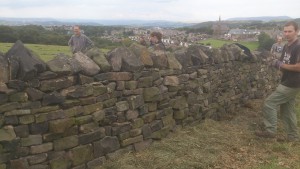
However, there’s nothing like creating something with your bare hands, and we left our sunny slope in Baxenden (did I mention it’s home of the Holland’s Pie factory??) having finished our section of wall and satisfied with the work that we’d completed.

Why not help to keep our traditional countryside crafts alive and have a go at dry stone walling yourself if you haven’t already! It’s more prevalent in some parts of the country due to favourable geology, but you will be able to find out what’s going on in your area through the DSWA website.

